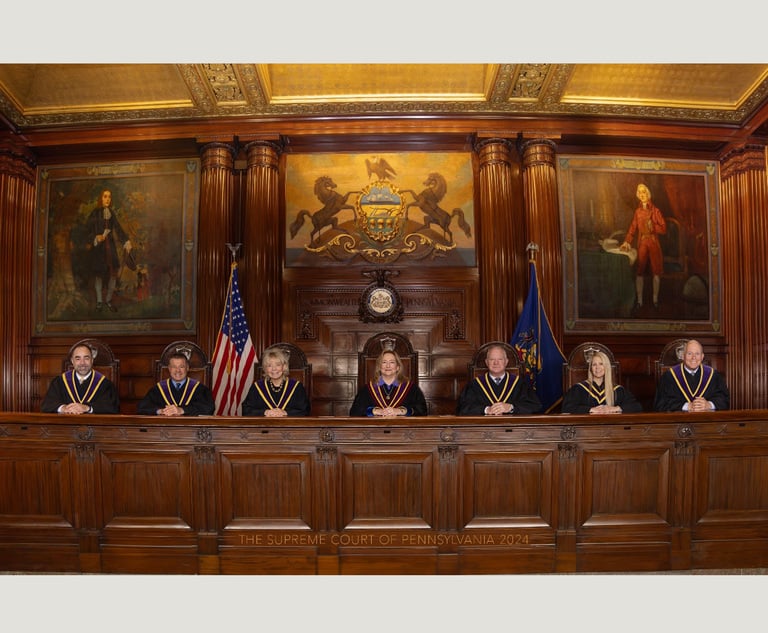 (L-R)Matthew Rosso and Elizabeth F. Vieyra of Reed Smith. Courtesy photos
(L-R)Matthew Rosso and Elizabeth F. Vieyra of Reed Smith. Courtesy photos Drafting Contractual Indemnity Provisions to Maximize Coverage Under Pa. Law
This article focuses on a just few of the many potential disputes that may arise with respect to indemnification under Pennsylvania law. Does the indemnification provision apply to claims for a party's own negligence?
September 07, 2023 at 12:29 PM
8 minute read
Indemnity provisions appear in almost all commercial contracts, from leasing agreements to service contracts and supply contracts. In many industries, standardized form contracts prepared by trade groups and used to facilitate quick transactions incorporate indemnity terms that parties may view as default provisions and accept without thought as to how courts actually interpret the provisions under applicable law. Language matters—as does the governing law. Parties should avoid adopting boilerplate indemnity provisions. Indemnity provisions should be drafted with an eye toward how disputes could arise in the context of the contract at issue and how courts applying the governing law would interpret the indemnity provision within the contract as a whole. This article focuses on a just few of the many potential disputes that may arise with respect to indemnification under Pennsylvania law.
- Does the indemnification provision apply to claims for a party's own negligence?
State laws differ with respect to their treatment of indemnification for negligent conduct. Under Pennsylvania law, courts follow the "Perry-Ruzzi" rule, under which "provisions to indemnify for another party's negligence are to be narrowly construed, requiring a clear and unequivocal agreement before a party may transfer its liability to another party." See Bernotas v. Super Fresh Food Markets, 963 A.2d 478, 482 (Pa. 2004). Under this rule, generic indemnification language (i.e., indemnification for "any and all liability") is insufficient to trigger indemnification for a party's own negligence. See Ruzzi v. Butler Petroleum, 588 A.2d 1, 2 (Pa. 1990). On the other hand, courts have found terms that provide for indemnification against loss caused "in whole or in part by any negligent act or omission … regardless of whether or not it is caused in part by a party indemnified hereunder" to be sufficiently specific. See Hershey Foods v. General Electric Service, 619 A.2d 285, 288 (Pa. Super. 1992). A promise to pay for "any and all claims … even though such damages, injury, loss or expense are attributable to the joint, concurrent or contributory negligence" of the indemnitee, also is sufficiently specific. See Ratti v. Wheeling Pittsburgh Steel, 758 A.2d 695, 702 (Pa. Super 2000).
- Does the indemnification provision apply to inter-party claims?
When a claim is asserted between contracting parties, and one contracting party seeks indemnity from the other contracting party, disputes typically arise concerning whether the parties' indemnification provision applies to inter-party or just third-party claims. Some Pennsylvania courts have suggested that indemnity is generally limited to third-party claims absent explicit language that includes claims between contracting parties. See Cottman Ave. PRP Group v. AMEC Foster Wheeler Environmental Infrastructure, 439 F. Supp. 3d 407, 438 (E.D. Pa. 2020) (collecting cases suggesting same). Other Pennsylvania courts have inferred an intent to include inter-party claims from the indemnity terms as well as the context and subject matter of the entire agreement. See Waynesborough Country Club v. Diedrich Niles Bolton Architects, 2008 U.S. Dist. LEXIS 93395, at *14 (E.D. Pa. Nov. 12, 2008) (finding inter-party claims within scope of indemnity). For example, in the context of a real estate transaction or other purchase agreement, the most probable (or even only possible) type of dispute arising from the contract might be one between the contracting parties. In such cases, where the context is clear, courts have held that the parties' indemnification provision was intended to apply to inter-party claims. See STS Holdings v. CDI, 2004 U.S. Dist. LEXIS 30984, *6 (E.D. Pa. Mar. 19, 2004) (interpreting indemnity provision to include inter-party claims arising from stock purchase agreement).
At the contract drafting stage, it may be best to expressly incorporate indemnity for inter-party claims to avoid any ambiguity—if that is the intended outcome. For example, in Keystone Care Administrative Services v. Grossinger, 159 A.3d 594 (Pa. Super. Ct. 2016), the court concluded that the parties intended for inter-party indemnity where the indemnity provision explicitly extended to "any breach by the indemnifying party of any representation, warranty, obligation or covenant under this agreement."
- Does the indemnification provision cover attorney fees and costs relating to the enforcement of such provision?
Indemnification provisions typically cover all loss, including attorney fees and costs, for defending any claim. However, parties often dispute whether the indemnification provision also covers fees and costs incurred in enforcing indemnity. Typically, under Pennsylvania law, an indemnitee may recover the costs of bringing an enforcement action under the rational that the indemnitor "could have avoided these fees and costs if it simply would have fulfilled its clear indemnification obligation." See Maule v. Philadelphia Media Holdings, 2010 U.S. Dist. LEXIS 105865, at *16 (E.D Pa. Oct. 1, 2010). However, to avoid any ambiguity, parties should consider explicitly specifying whether attorney fees and costs incurred in enforcing indemnification rights are included within the scope of the indemnification provision. Along these same lines, parties also should consider specifying whether other damages that may arise from a breach of the indemnity agreement—for example pre- and post-judgment interest, costs, and expenses—are considered "loss" within the scope of the indemnity provision.
- Who controls and pays for the defense?
Disputes also typically arise concerning whether the indemnifying party agreed to provide a defense and, if so, the scope of such defense. With respect to third-party claims, for example, parties should consider specifying whether the indemnitor will defend the indemnitee against third-party claims. If there is a duty to defend, the parties also should consider specifying which party will control the defense. An indemnitor may control the defense of third-party claims, provided it does so in good faith, offers a full an unconflicted defense, and makes reasonable settlement decisions in the best interest of the indemnitee. See American & Foreign Insurance v. Jerry's Sport Center, 2 A.3d 526, 545 (Pa. 2010). In other cases, parties may wish to negotiate for the payment of attorney fees by the indemnitor, while the indemnitee controls the defense. In that instance, language providing indemnity "from and against any and all … expenses (including reasonable attorney fees)" is typically used. When considering who controls and/or pays for the defense, parties should consider, among other things, how much involvement they would want or need when defending any claims brought against the company under the subject contract, who they would want to retain to defend them, and how important it is that they retain the right to select their own defense counsel.
- Other limitations to keep in mind.
Parties are free to draft indemnity provisions as they wish and courts endeavor to enforce such provisions consistent with the intent of the parties, unless they are deemed to conflict with public policy. In Pennsylvania, for example, courts have found that a party cannot agree to indemnify another party against punitive damages. See TIG Insurance v. Nobel Learning Community, 2002 U.S. Dist. LEXIS 10870, at *43-44 (E.D. Pa. June 19, 2002). The rationale is that punitive damages serve to punish and deter wrongdoing, two goals that would be undermined if a party were allowed to shift such liability. Similarly, some authorities suggest that policy consideration would support disallowing indemnity for gross negligence. However, existing authority states that gross negligence may be included in an indemnification provision if the language is express. While parties should endeavor to make their intent as clear as possible when drafting contractual indemnity provisions, it is important to keep in mind that if it conflicts with public policy, it may be void.
This content has been archived. It is available through our partners, LexisNexis® and Bloomberg Law.
To view this content, please continue to their sites.
Not a Lexis Subscriber?
Subscribe Now
Not a Bloomberg Law Subscriber?
Subscribe Now
NOT FOR REPRINT
© 2025 ALM Global, LLC, All Rights Reserved. Request academic re-use from www.copyright.com. All other uses, submit a request to [email protected]. For more information visit Asset & Logo Licensing.
You Might Like
View All

Third Circuit Predicts Pa. High Court's Application of 'Gallagher' and 'Donovan' in 'Mid-Century Insurance v. Werley'
12 minute read
After the Decision in 'Ungarean,' Is the Battle of Insurance Coverage for COVID Losses in Pa. Over?

Pa. High Court Shuts Down Insurance Coverage of COVID-19 Financial Losses
4 minute readLaw Firms Mentioned
Trending Stories
- 1We the People?
- 2New York-Based Skadden Team Joins White & Case Group in Mexico City for Citigroup Demerger
- 3No Two Wildfires Alike: Lawyers Take Different Legal Strategies in California
- 4Poop-Themed Dog Toy OK as Parody, but Still Tarnished Jack Daniel’s Brand, Court Says
- 5Meet the New President of NY's Association of Trial Court Jurists
Who Got The Work
J. Brugh Lower of Gibbons has entered an appearance for industrial equipment supplier Devco Corporation in a pending trademark infringement lawsuit. The suit, accusing the defendant of selling knock-off Graco products, was filed Dec. 18 in New Jersey District Court by Rivkin Radler on behalf of Graco Inc. and Graco Minnesota. The case, assigned to U.S. District Judge Zahid N. Quraishi, is 3:24-cv-11294, Graco Inc. et al v. Devco Corporation.
Who Got The Work
Rebecca Maller-Stein and Kent A. Yalowitz of Arnold & Porter Kaye Scholer have entered their appearances for Hanaco Venture Capital and its executives, Lior Prosor and David Frankel, in a pending securities lawsuit. The action, filed on Dec. 24 in New York Southern District Court by Zell, Aron & Co. on behalf of Goldeneye Advisors, accuses the defendants of negligently and fraudulently managing the plaintiff's $1 million investment. The case, assigned to U.S. District Judge Vernon S. Broderick, is 1:24-cv-09918, Goldeneye Advisors, LLC v. Hanaco Venture Capital, Ltd. et al.
Who Got The Work
Attorneys from A&O Shearman has stepped in as defense counsel for Toronto-Dominion Bank and other defendants in a pending securities class action. The suit, filed Dec. 11 in New York Southern District Court by Bleichmar Fonti & Auld, accuses the defendants of concealing the bank's 'pervasive' deficiencies in regards to its compliance with the Bank Secrecy Act and the quality of its anti-money laundering controls. The case, assigned to U.S. District Judge Arun Subramanian, is 1:24-cv-09445, Gonzalez v. The Toronto-Dominion Bank et al.
Who Got The Work
Crown Castle International, a Pennsylvania company providing shared communications infrastructure, has turned to Luke D. Wolf of Gordon Rees Scully Mansukhani to fend off a pending breach-of-contract lawsuit. The court action, filed Nov. 25 in Michigan Eastern District Court by Hooper Hathaway PC on behalf of The Town Residences LLC, accuses Crown Castle of failing to transfer approximately $30,000 in utility payments from T-Mobile in breach of a roof-top lease and assignment agreement. The case, assigned to U.S. District Judge Susan K. Declercq, is 2:24-cv-13131, The Town Residences LLC v. T-Mobile US, Inc. et al.
Who Got The Work
Wilfred P. Coronato and Daniel M. Schwartz of McCarter & English have stepped in as defense counsel to Electrolux Home Products Inc. in a pending product liability lawsuit. The court action, filed Nov. 26 in New York Eastern District Court by Poulos Lopiccolo PC and Nagel Rice LLP on behalf of David Stern, alleges that the defendant's refrigerators’ drawers and shelving repeatedly break and fall apart within months after purchase. The case, assigned to U.S. District Judge Joan M. Azrack, is 2:24-cv-08204, Stern v. Electrolux Home Products, Inc.
Featured Firms
Law Offices of Gary Martin Hays & Associates, P.C.
(470) 294-1674
Law Offices of Mark E. Salomone
(857) 444-6468
Smith & Hassler
(713) 739-1250





